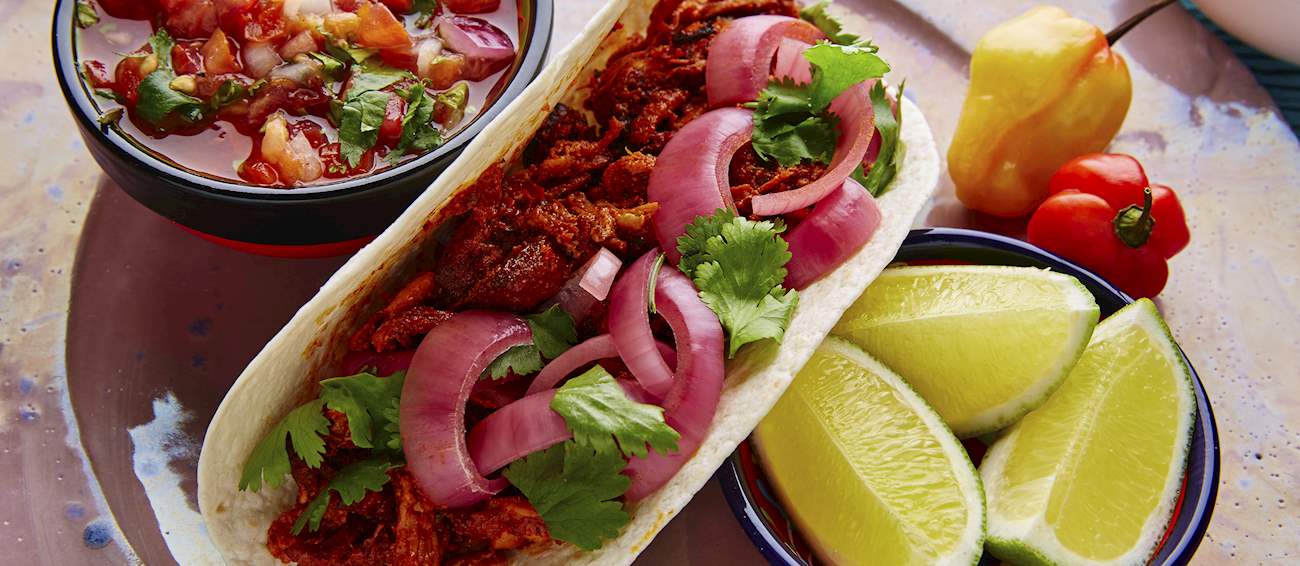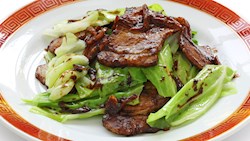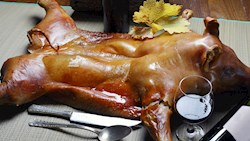Gringas is a typical Mexican dish made with flour tortillas filled with al pastor marinated pork meat, cheese, and, most commonly, pineapple slices, although onions, chili sauce, and coriander can all be added to the dish according to the customer's preference.
The combination of these ingredients is then grilled in the same manner as a quesadilla. The tortillas are usually folded in half and consumed like a taco. The name of the dish, a feminine form of gringo, is believed to have come from the idea that flour tortillas are more popular than corn tortillas north of the Mexican border.
MOST ICONIC Gringas
View moreCochinita pibil is a Mexican pork dish originating from Yucatan. Pork is marinated in a combination of annatto paste, bitter orange juice, and garlic. It is slowly baked and then shredded and served on tortillas, tacos, or on its own with shallots, pickled onions, salsa, and various roasted vegetables.
Cochinita pibil is characterized by the red color of the meat, imparted by the annatto seeds from the marinade. Originally, pork was wrapped in banana leaves prior to baking, but today a foil or any other suitable wrapping can be used instead. Since cochinita means baby pig, and pibil means buried or underground, it acts as a proof that the original recipe used a whole suckling pig that was buried in a pit for roasting.
MOST ICONIC Cochinita pibil
View moreChilorio is a Sinaloan dish consisting of fried pulled pork meat that is cooked in chili sauce and spices such oregano, garlic, and cumin. Originally, it was used as a way to preserve meat, but today it is usually used as a filling for numerous Mexican specialties such as tacos or enchiladas.
If chilorio is served as a main dish, it is traditionally accompanied by salsa, guacamole, Mexican rice, or refried beans on the side.
MAIN INGREDIENTS
Kontosouvli is a traditional dish consisting of large pieces of pork marinated in a mixture of herbs and spices, then skewered and slowly cooked on a rotisserie, much like a gyro or souvlaki. The marinade often contains ingredients such as garlic, oregano, thyme, rosemary, paprika, olive oil, lemon juice, and red wine.
After marinating, the meat is threaded onto a large skewer and roasted over an open flame, which results in a rich and flavorful outer crust with a juicy, tender interior. The cooked meat is typically served in thick slices, often accompanied by pita bread, tzatziki sauce, and horiatiki salad, among other possible accompaniments.
Originating from the Mexican state of Michoacán, carnitas is a flavorful dish made from pork (usually front sections or pork shoulder) that is braised, roasted, or slow-cooked in its own fat for a long time until fully tender and succulent.
The heat is then turned up until the meat is crispy on the exterior and can be shredded. Carnitas, which translates to little meats, is often served with tortillas, accompanied by salsas, beans, guacamole, lime, or fresh vegetables. In Michoacán, carnitas are found everywhere from street stalls to upscale restaurants, although the dish is more often made for special occasions such as Christmas, anniversaries, or birthdays.
MOST ICONIC Carnitas
View moreSamgyeopsal is a South Korean delicacy consisting only of pork belly, the most expensive cut of pork in the country. It is so popular in South Korea that the residents eat it approximately once every four days. The name of the dish consists of three words: sam (three), gyeop (layered), and sal (meat), so it can be literally translated as three-layered meat, referring to the three visible layers of the meat.
It is believed that the dish became popular in the 1960s, when the price of soju decreased and people needed a dish to go with it, so they chose pork belly due to its low price at the time. Whether at home or in restaurants, samgyeopsal is traditionally cooked at the table in a special pan which is designed to let the fat run off the sides of it.
MOST ICONIC Samgyeopsal
View morePernil is one of Puerto Rico's most famous dishes, a succulent roasted pork shoulder that is traditionally seasoned in a marinade called adobo mojado, consisting of paprika, salt, vinegar, garlic, and oregano. The name of the dish is derived from the Spanish word pierna, meaning leg, but it is also a Catalan word for ham, referring to the traditional recipe that calls for fresh ham.
Because pork shoulder is more available and costs less than ham, it has become a key ingredient in pernil. Many people prefer it since it is believed to be much more flavorful than ham. The dish is a staple at numerous Puerto Rican festivities such as birthdays or weddings, where many people feast on the crunchy skin and tender meat that falls off the bone.
MOST ICONIC Pernil
View moreTacos al pastor is a Mexican dish consisting of thin slices of shaved pork from a rotating spit, placed on a tortilla and topped with onions, chopped coriander, pineapple chunks, chili, and salsa. The dish evolved from the Lebanese culinary traditions that arrived in Mexico in the late 19th century along with numerous immigrants.
It stems from the popular shawarma, but the Mexicans changed the spices and substituted lamb with pork. Tacos al pastor originated in the city of Puebla, and their name is translated to shepherd's style tacos. However, the addition of pineapple to the dish still remains a mystery to be solved.
MOST ICONIC Tacos al pastor
View moreMAIN INGREDIENTS
Lechona is a traditional dish consisting of a roasted pig stuffed with onions, peas, fresh herbs, and various spices. The pig is roasted for a long time until the meat is tender and succulent. The dish is usually prepared for celebrations and festivities since one lechona can produce as many as 100 servings.
This unique Colombian delicacy can be found in numerous restaurants throughout the country's largest cities.
Bossam is a South Korean dish consisting of sliced and steamed pork that is wrapped in leaves of vegetables such as chard, beetroot, lettuce, or Chinese cabbage. When properly prepared, the meat should have a delicately smooth, creamy taste. It is often accompanied by rice, sweet kimchi, and shrimp sauce.
The dish is traditionally served as anju, denoting dishes that go well with alcoholic beverages. Bossam is a classic example of a simple dish that really comes together with the addition of numerous condiments and toppings, so many restaurants like to serve it with side dishes such as kimchi stew, dwenjang jjigae, or seafood pancakes.
TasteAtlas food rankings are based on the ratings of the TasteAtlas audience, with a series of mechanisms that recognize real users and that ignore bot, nationalist or local patriotic ratings, and give additional value to the ratings of users that the system recognizes as knowledgeable. For the “Top 100 Pork Dishes in the World” list until March 20, 2025, 12,396 ratings were recorded, of which 8,171 were recognized by the system as legitimate. TasteAtlas Rankings should not be seen as the final global conclusion about food. Their purpose is to promote excellent local foods, instill pride in traditional dishes, and arouse curiosity about dishes you haven’t tried.






























































































































